Application of Conceptual Framework and Australian Accounting Standards by Acorn Capital Investment Fund Limited
VerifiedAdded on 2023/05/28
|11
|2198
|156
AI Summary
This report analyzes the application of the conceptual framework and the Australian Accounting Standards by the Acorn Capital Investment Fund Limited. It focuses on the methods used by the company to measure its financial instruments, compliance with fundamental and enhanced qualitative financial reporting characteristics, and the reliance on Acorn’s financial report to make financial decisions.
Contribute Materials
Your contribution can guide someone’s learning journey. Share your
documents today.
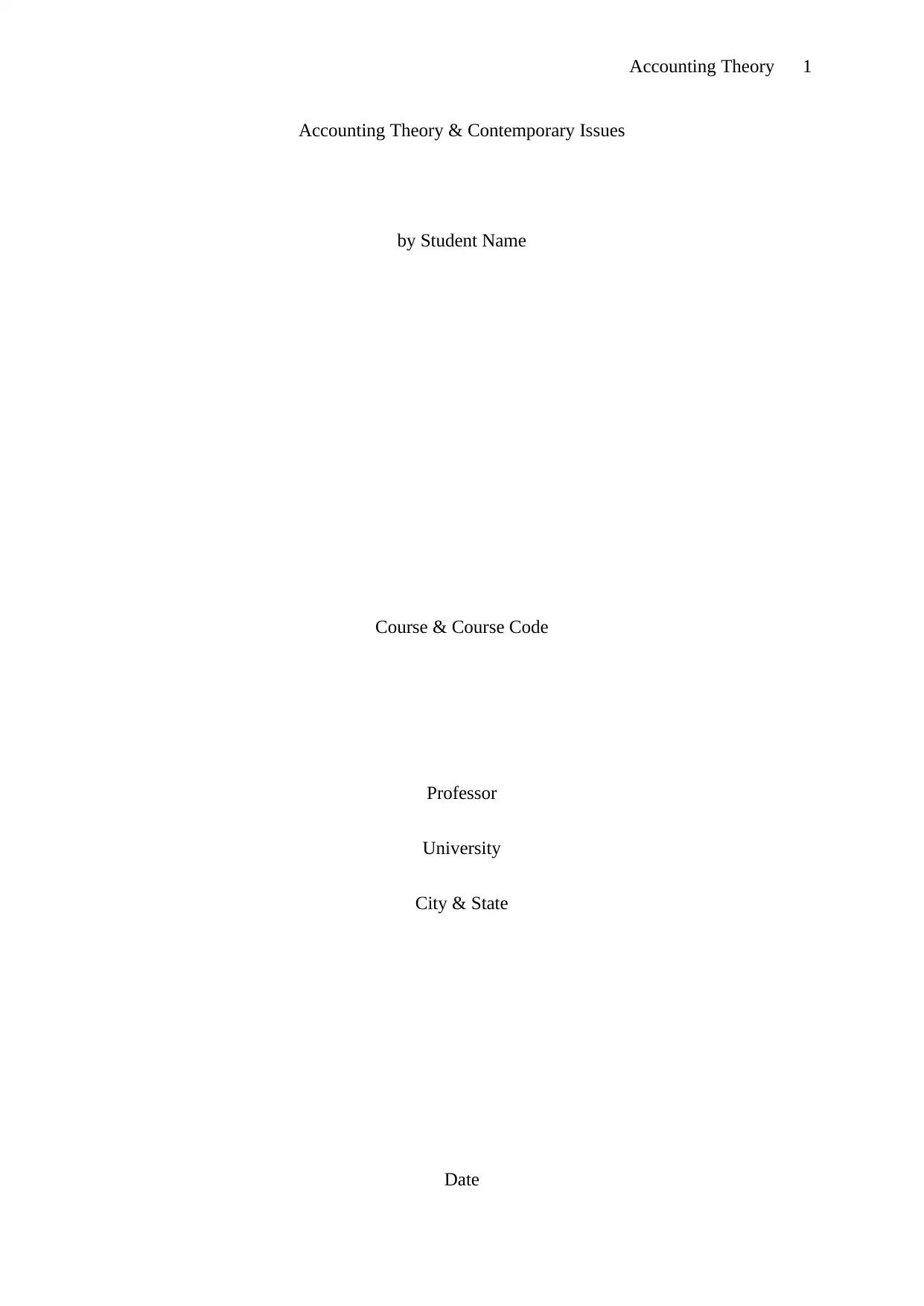
Accounting Theory 1
Accounting Theory & Contemporary Issues
by Student Name
Course & Course Code
Professor
University
City & State
Date
Accounting Theory & Contemporary Issues
by Student Name
Course & Course Code
Professor
University
City & State
Date
Secure Best Marks with AI Grader
Need help grading? Try our AI Grader for instant feedback on your assignments.
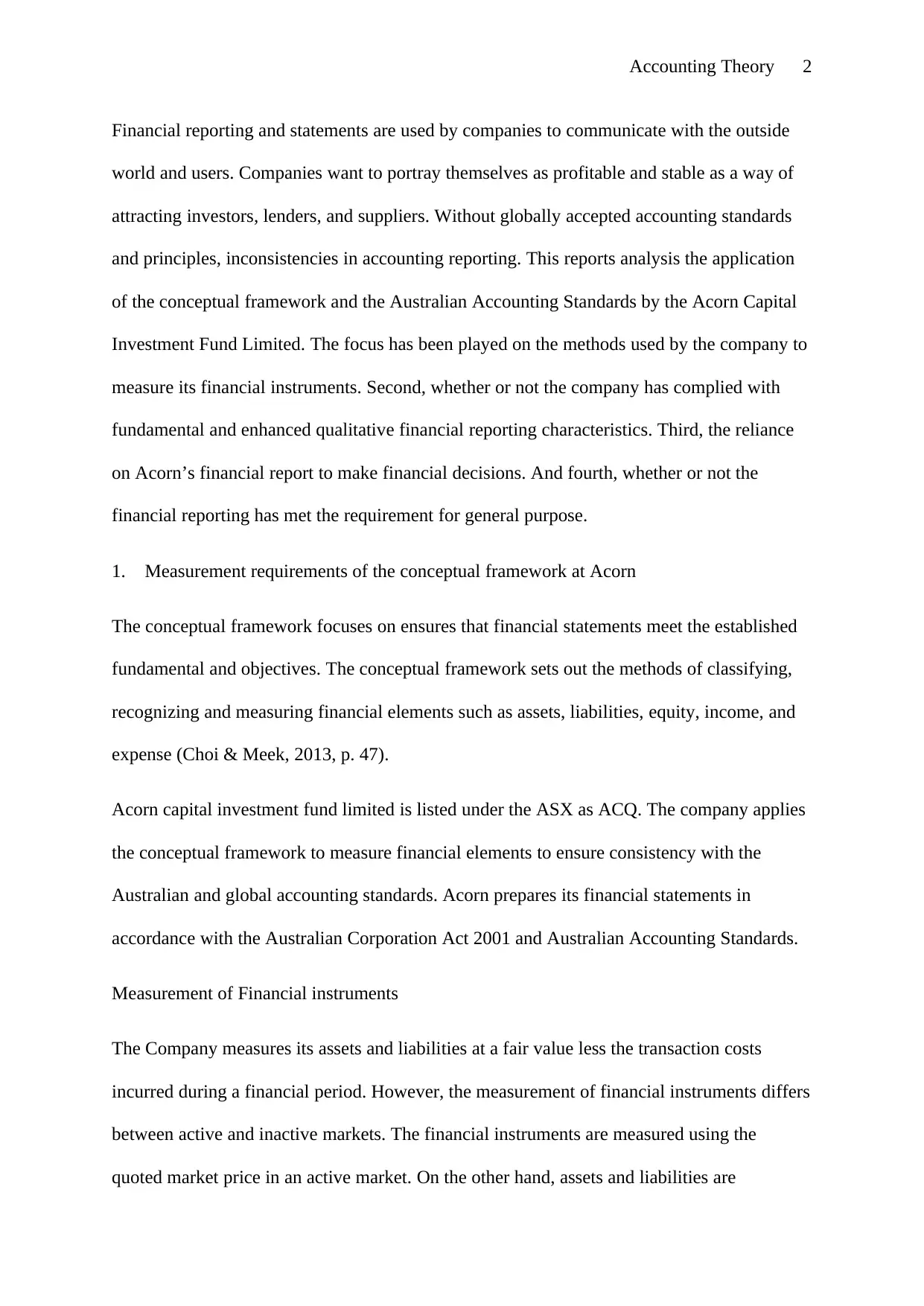
Accounting Theory 2
Financial reporting and statements are used by companies to communicate with the outside
world and users. Companies want to portray themselves as profitable and stable as a way of
attracting investors, lenders, and suppliers. Without globally accepted accounting standards
and principles, inconsistencies in accounting reporting. This reports analysis the application
of the conceptual framework and the Australian Accounting Standards by the Acorn Capital
Investment Fund Limited. The focus has been played on the methods used by the company to
measure its financial instruments. Second, whether or not the company has complied with
fundamental and enhanced qualitative financial reporting characteristics. Third, the reliance
on Acorn’s financial report to make financial decisions. And fourth, whether or not the
financial reporting has met the requirement for general purpose.
1. Measurement requirements of the conceptual framework at Acorn
The conceptual framework focuses on ensures that financial statements meet the established
fundamental and objectives. The conceptual framework sets out the methods of classifying,
recognizing and measuring financial elements such as assets, liabilities, equity, income, and
expense (Choi & Meek, 2013, p. 47).
Acorn capital investment fund limited is listed under the ASX as ACQ. The company applies
the conceptual framework to measure financial elements to ensure consistency with the
Australian and global accounting standards. Acorn prepares its financial statements in
accordance with the Australian Corporation Act 2001 and Australian Accounting Standards.
Measurement of Financial instruments
The Company measures its assets and liabilities at a fair value less the transaction costs
incurred during a financial period. However, the measurement of financial instruments differs
between active and inactive markets. The financial instruments are measured using the
quoted market price in an active market. On the other hand, assets and liabilities are
Financial reporting and statements are used by companies to communicate with the outside
world and users. Companies want to portray themselves as profitable and stable as a way of
attracting investors, lenders, and suppliers. Without globally accepted accounting standards
and principles, inconsistencies in accounting reporting. This reports analysis the application
of the conceptual framework and the Australian Accounting Standards by the Acorn Capital
Investment Fund Limited. The focus has been played on the methods used by the company to
measure its financial instruments. Second, whether or not the company has complied with
fundamental and enhanced qualitative financial reporting characteristics. Third, the reliance
on Acorn’s financial report to make financial decisions. And fourth, whether or not the
financial reporting has met the requirement for general purpose.
1. Measurement requirements of the conceptual framework at Acorn
The conceptual framework focuses on ensures that financial statements meet the established
fundamental and objectives. The conceptual framework sets out the methods of classifying,
recognizing and measuring financial elements such as assets, liabilities, equity, income, and
expense (Choi & Meek, 2013, p. 47).
Acorn capital investment fund limited is listed under the ASX as ACQ. The company applies
the conceptual framework to measure financial elements to ensure consistency with the
Australian and global accounting standards. Acorn prepares its financial statements in
accordance with the Australian Corporation Act 2001 and Australian Accounting Standards.
Measurement of Financial instruments
The Company measures its assets and liabilities at a fair value less the transaction costs
incurred during a financial period. However, the measurement of financial instruments differs
between active and inactive markets. The financial instruments are measured using the
quoted market price in an active market. On the other hand, assets and liabilities are
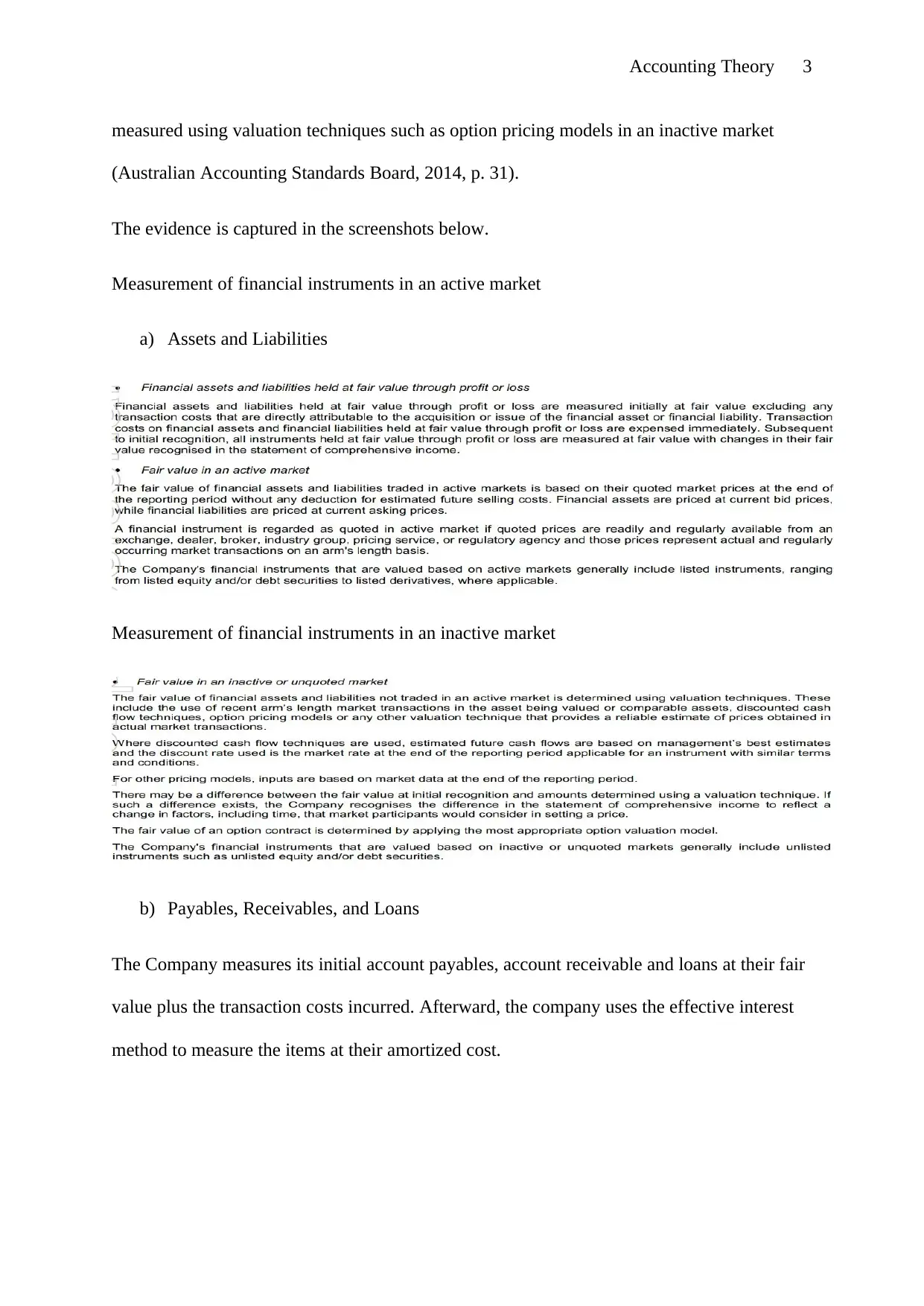
Accounting Theory 3
measured using valuation techniques such as option pricing models in an inactive market
(Australian Accounting Standards Board, 2014, p. 31).
The evidence is captured in the screenshots below.
Measurement of financial instruments in an active market
a) Assets and Liabilities
Measurement of financial instruments in an inactive market
b) Payables, Receivables, and Loans
The Company measures its initial account payables, account receivable and loans at their fair
value plus the transaction costs incurred. Afterward, the company uses the effective interest
method to measure the items at their amortized cost.
measured using valuation techniques such as option pricing models in an inactive market
(Australian Accounting Standards Board, 2014, p. 31).
The evidence is captured in the screenshots below.
Measurement of financial instruments in an active market
a) Assets and Liabilities
Measurement of financial instruments in an inactive market
b) Payables, Receivables, and Loans
The Company measures its initial account payables, account receivable and loans at their fair
value plus the transaction costs incurred. Afterward, the company uses the effective interest
method to measure the items at their amortized cost.
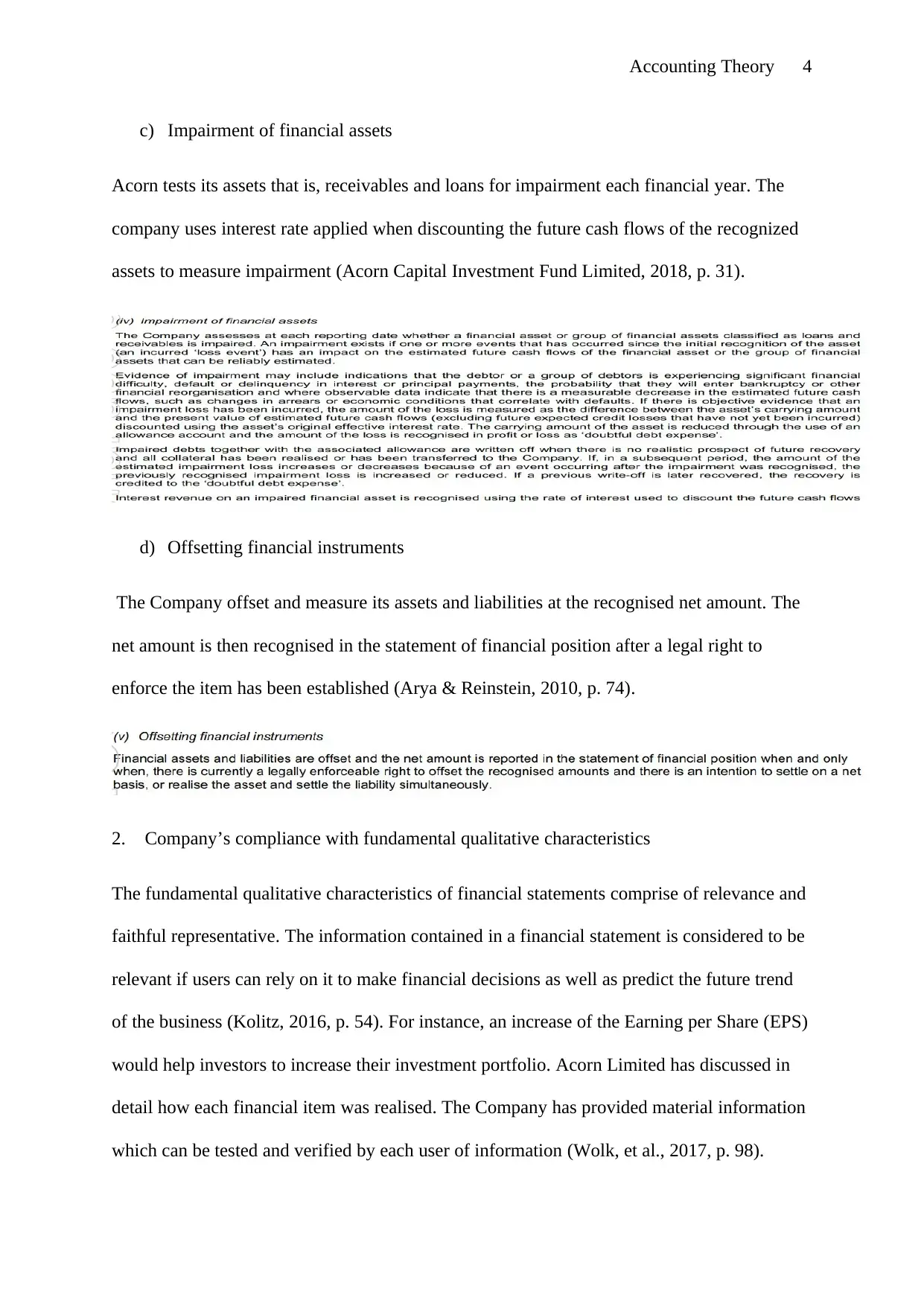
Accounting Theory 4
c) Impairment of financial assets
Acorn tests its assets that is, receivables and loans for impairment each financial year. The
company uses interest rate applied when discounting the future cash flows of the recognized
assets to measure impairment (Acorn Capital Investment Fund Limited, 2018, p. 31).
d) Offsetting financial instruments
The Company offset and measure its assets and liabilities at the recognised net amount. The
net amount is then recognised in the statement of financial position after a legal right to
enforce the item has been established (Arya & Reinstein, 2010, p. 74).
2. Company’s compliance with fundamental qualitative characteristics
The fundamental qualitative characteristics of financial statements comprise of relevance and
faithful representative. The information contained in a financial statement is considered to be
relevant if users can rely on it to make financial decisions as well as predict the future trend
of the business (Kolitz, 2016, p. 54). For instance, an increase of the Earning per Share (EPS)
would help investors to increase their investment portfolio. Acorn Limited has discussed in
detail how each financial item was realised. The Company has provided material information
which can be tested and verified by each user of information (Wolk, et al., 2017, p. 98).
c) Impairment of financial assets
Acorn tests its assets that is, receivables and loans for impairment each financial year. The
company uses interest rate applied when discounting the future cash flows of the recognized
assets to measure impairment (Acorn Capital Investment Fund Limited, 2018, p. 31).
d) Offsetting financial instruments
The Company offset and measure its assets and liabilities at the recognised net amount. The
net amount is then recognised in the statement of financial position after a legal right to
enforce the item has been established (Arya & Reinstein, 2010, p. 74).
2. Company’s compliance with fundamental qualitative characteristics
The fundamental qualitative characteristics of financial statements comprise of relevance and
faithful representative. The information contained in a financial statement is considered to be
relevant if users can rely on it to make financial decisions as well as predict the future trend
of the business (Kolitz, 2016, p. 54). For instance, an increase of the Earning per Share (EPS)
would help investors to increase their investment portfolio. Acorn Limited has discussed in
detail how each financial item was realised. The Company has provided material information
which can be tested and verified by each user of information (Wolk, et al., 2017, p. 98).
Secure Best Marks with AI Grader
Need help grading? Try our AI Grader for instant feedback on your assignments.
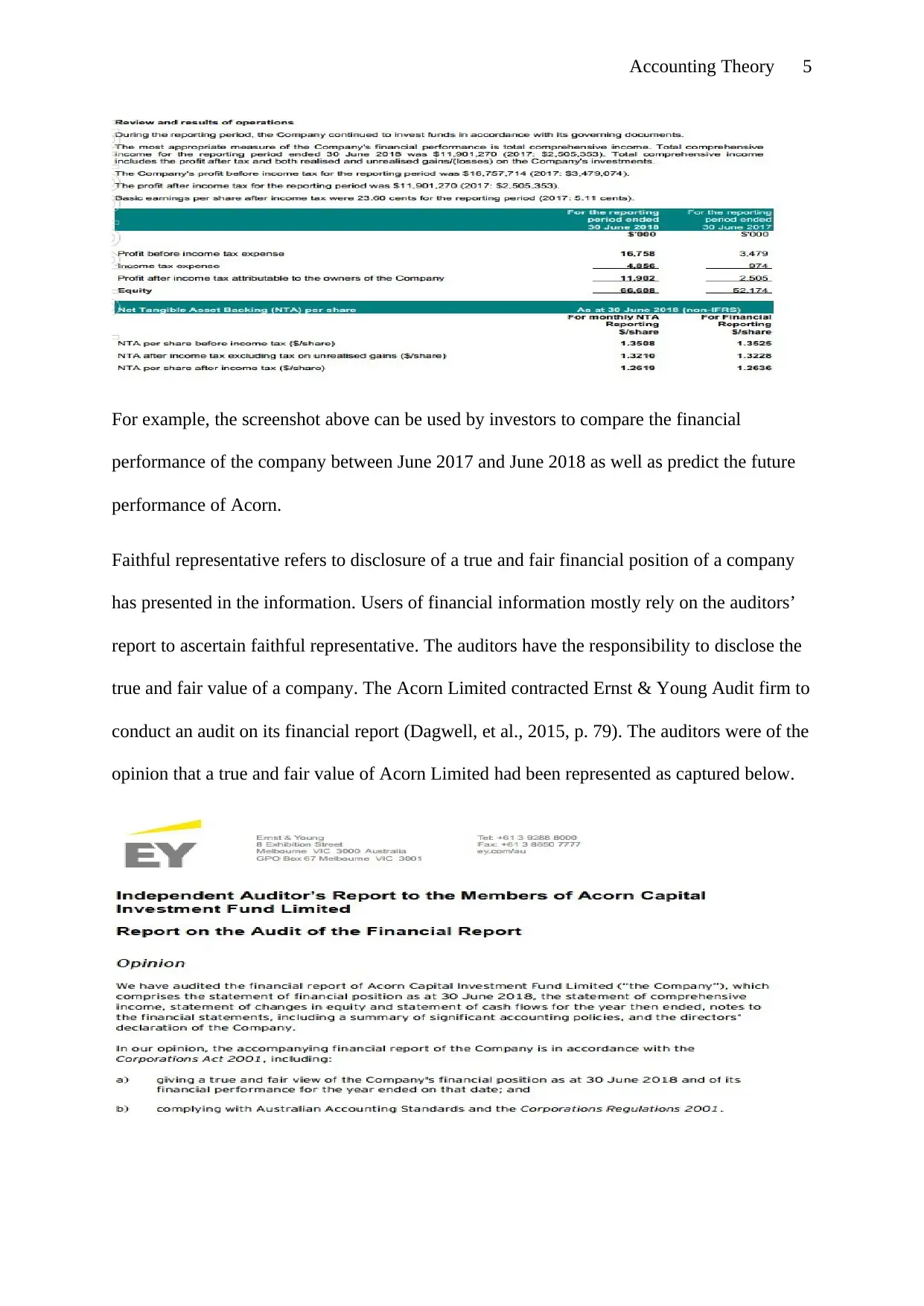
Accounting Theory 5
For example, the screenshot above can be used by investors to compare the financial
performance of the company between June 2017 and June 2018 as well as predict the future
performance of Acorn.
Faithful representative refers to disclosure of a true and fair financial position of a company
has presented in the information. Users of financial information mostly rely on the auditors’
report to ascertain faithful representative. The auditors have the responsibility to disclose the
true and fair value of a company. The Acorn Limited contracted Ernst & Young Audit firm to
conduct an audit on its financial report (Dagwell, et al., 2015, p. 79). The auditors were of the
opinion that a true and fair value of Acorn Limited had been represented as captured below.
For example, the screenshot above can be used by investors to compare the financial
performance of the company between June 2017 and June 2018 as well as predict the future
performance of Acorn.
Faithful representative refers to disclosure of a true and fair financial position of a company
has presented in the information. Users of financial information mostly rely on the auditors’
report to ascertain faithful representative. The auditors have the responsibility to disclose the
true and fair value of a company. The Acorn Limited contracted Ernst & Young Audit firm to
conduct an audit on its financial report (Dagwell, et al., 2015, p. 79). The auditors were of the
opinion that a true and fair value of Acorn Limited had been represented as captured below.
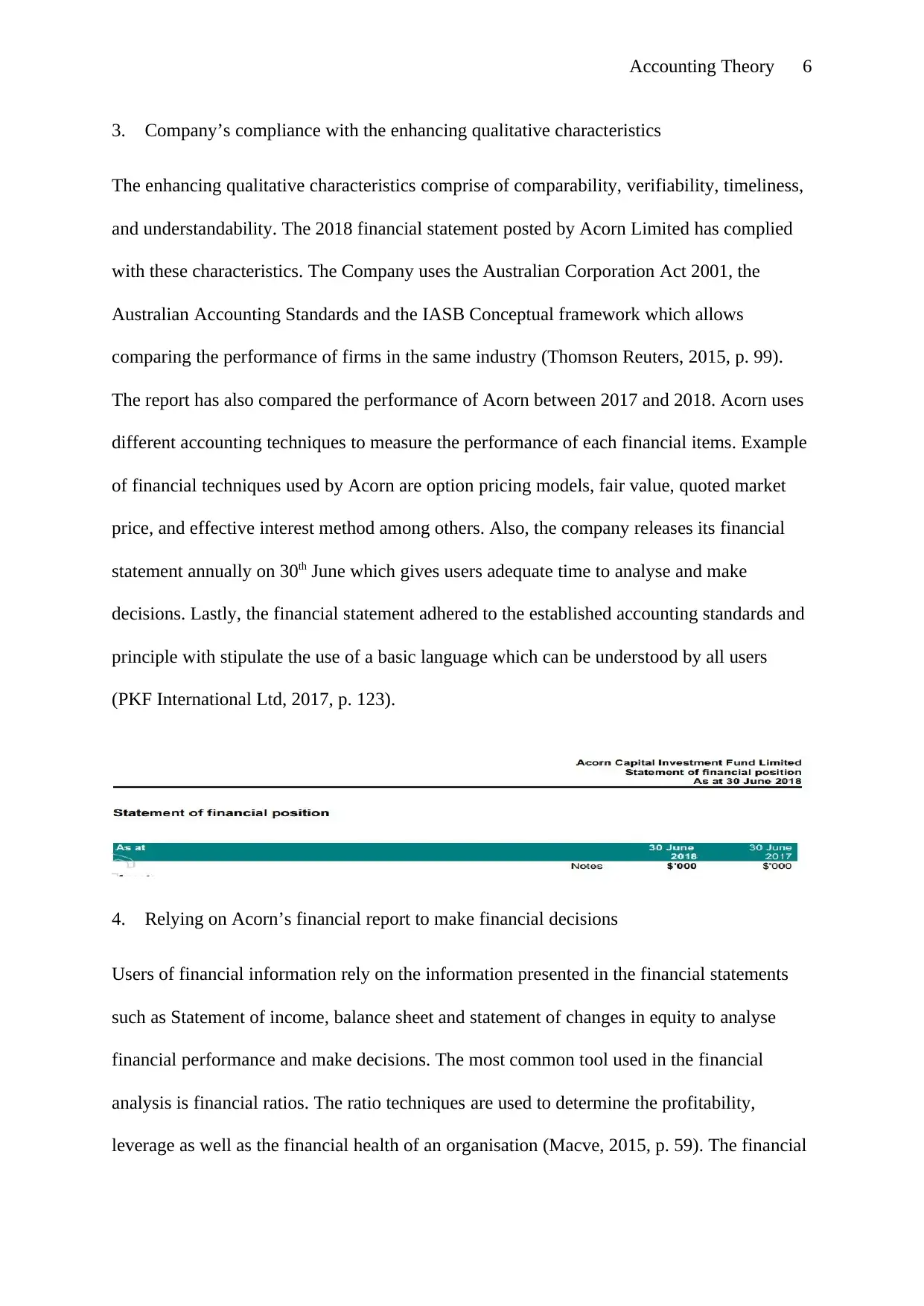
Accounting Theory 6
3. Company’s compliance with the enhancing qualitative characteristics
The enhancing qualitative characteristics comprise of comparability, verifiability, timeliness,
and understandability. The 2018 financial statement posted by Acorn Limited has complied
with these characteristics. The Company uses the Australian Corporation Act 2001, the
Australian Accounting Standards and the IASB Conceptual framework which allows
comparing the performance of firms in the same industry (Thomson Reuters, 2015, p. 99).
The report has also compared the performance of Acorn between 2017 and 2018. Acorn uses
different accounting techniques to measure the performance of each financial items. Example
of financial techniques used by Acorn are option pricing models, fair value, quoted market
price, and effective interest method among others. Also, the company releases its financial
statement annually on 30th June which gives users adequate time to analyse and make
decisions. Lastly, the financial statement adhered to the established accounting standards and
principle with stipulate the use of a basic language which can be understood by all users
(PKF International Ltd, 2017, p. 123).
4. Relying on Acorn’s financial report to make financial decisions
Users of financial information rely on the information presented in the financial statements
such as Statement of income, balance sheet and statement of changes in equity to analyse
financial performance and make decisions. The most common tool used in the financial
analysis is financial ratios. The ratio techniques are used to determine the profitability,
leverage as well as the financial health of an organisation (Macve, 2015, p. 59). The financial
3. Company’s compliance with the enhancing qualitative characteristics
The enhancing qualitative characteristics comprise of comparability, verifiability, timeliness,
and understandability. The 2018 financial statement posted by Acorn Limited has complied
with these characteristics. The Company uses the Australian Corporation Act 2001, the
Australian Accounting Standards and the IASB Conceptual framework which allows
comparing the performance of firms in the same industry (Thomson Reuters, 2015, p. 99).
The report has also compared the performance of Acorn between 2017 and 2018. Acorn uses
different accounting techniques to measure the performance of each financial items. Example
of financial techniques used by Acorn are option pricing models, fair value, quoted market
price, and effective interest method among others. Also, the company releases its financial
statement annually on 30th June which gives users adequate time to analyse and make
decisions. Lastly, the financial statement adhered to the established accounting standards and
principle with stipulate the use of a basic language which can be understood by all users
(PKF International Ltd, 2017, p. 123).
4. Relying on Acorn’s financial report to make financial decisions
Users of financial information rely on the information presented in the financial statements
such as Statement of income, balance sheet and statement of changes in equity to analyse
financial performance and make decisions. The most common tool used in the financial
analysis is financial ratios. The ratio techniques are used to determine the profitability,
leverage as well as the financial health of an organisation (Macve, 2015, p. 59). The financial
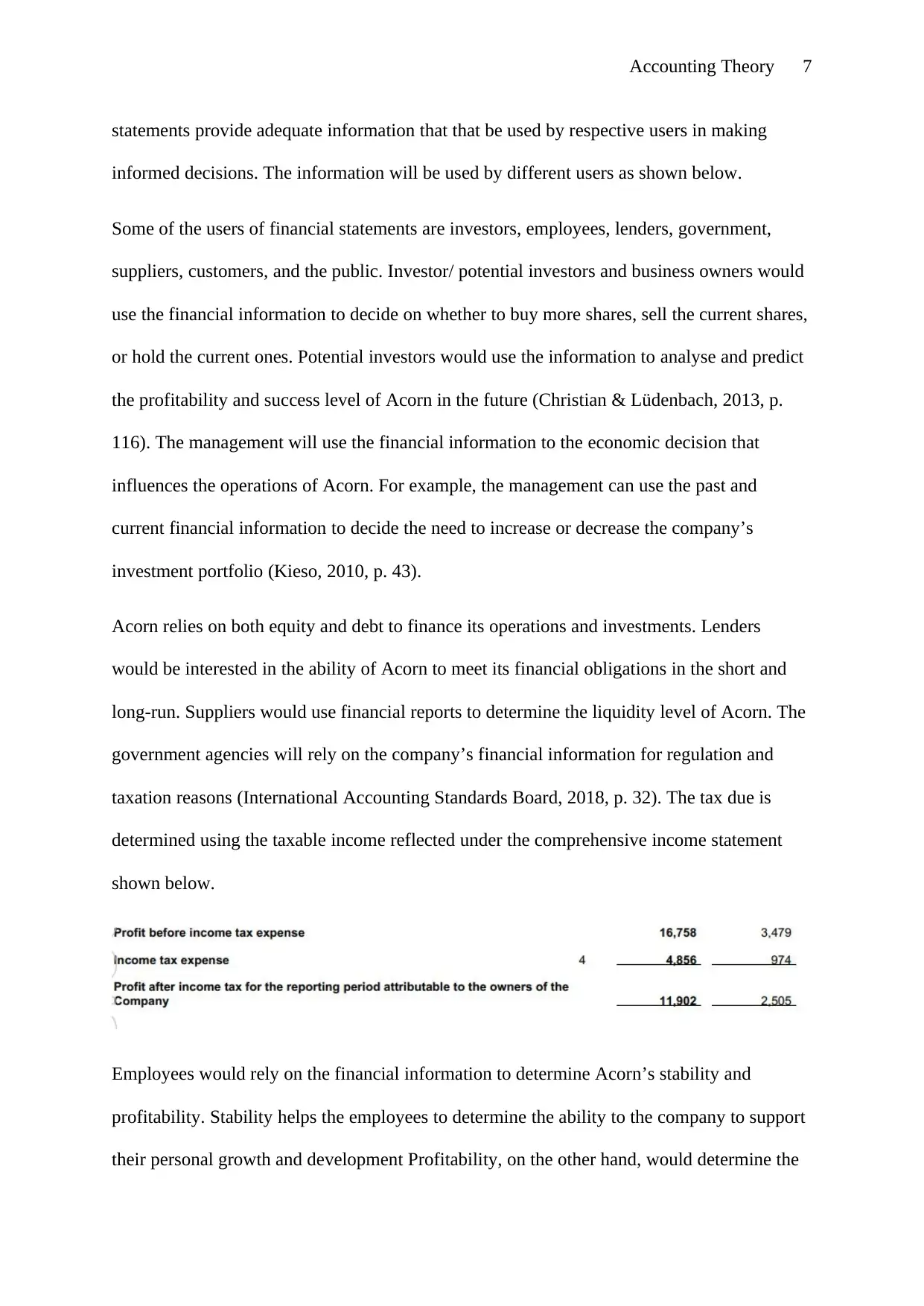
Accounting Theory 7
statements provide adequate information that that be used by respective users in making
informed decisions. The information will be used by different users as shown below.
Some of the users of financial statements are investors, employees, lenders, government,
suppliers, customers, and the public. Investor/ potential investors and business owners would
use the financial information to decide on whether to buy more shares, sell the current shares,
or hold the current ones. Potential investors would use the information to analyse and predict
the profitability and success level of Acorn in the future (Christian & Lüdenbach, 2013, p.
116). The management will use the financial information to the economic decision that
influences the operations of Acorn. For example, the management can use the past and
current financial information to decide the need to increase or decrease the company’s
investment portfolio (Kieso, 2010, p. 43).
Acorn relies on both equity and debt to finance its operations and investments. Lenders
would be interested in the ability of Acorn to meet its financial obligations in the short and
long-run. Suppliers would use financial reports to determine the liquidity level of Acorn. The
government agencies will rely on the company’s financial information for regulation and
taxation reasons (International Accounting Standards Board, 2018, p. 32). The tax due is
determined using the taxable income reflected under the comprehensive income statement
shown below.
Employees would rely on the financial information to determine Acorn’s stability and
profitability. Stability helps the employees to determine the ability to the company to support
their personal growth and development Profitability, on the other hand, would determine the
statements provide adequate information that that be used by respective users in making
informed decisions. The information will be used by different users as shown below.
Some of the users of financial statements are investors, employees, lenders, government,
suppliers, customers, and the public. Investor/ potential investors and business owners would
use the financial information to decide on whether to buy more shares, sell the current shares,
or hold the current ones. Potential investors would use the information to analyse and predict
the profitability and success level of Acorn in the future (Christian & Lüdenbach, 2013, p.
116). The management will use the financial information to the economic decision that
influences the operations of Acorn. For example, the management can use the past and
current financial information to decide the need to increase or decrease the company’s
investment portfolio (Kieso, 2010, p. 43).
Acorn relies on both equity and debt to finance its operations and investments. Lenders
would be interested in the ability of Acorn to meet its financial obligations in the short and
long-run. Suppliers would use financial reports to determine the liquidity level of Acorn. The
government agencies will rely on the company’s financial information for regulation and
taxation reasons (International Accounting Standards Board, 2018, p. 32). The tax due is
determined using the taxable income reflected under the comprehensive income statement
shown below.
Employees would rely on the financial information to determine Acorn’s stability and
profitability. Stability helps the employees to determine the ability to the company to support
their personal growth and development Profitability, on the other hand, would determine the
Paraphrase This Document
Need a fresh take? Get an instant paraphrase of this document with our AI Paraphraser
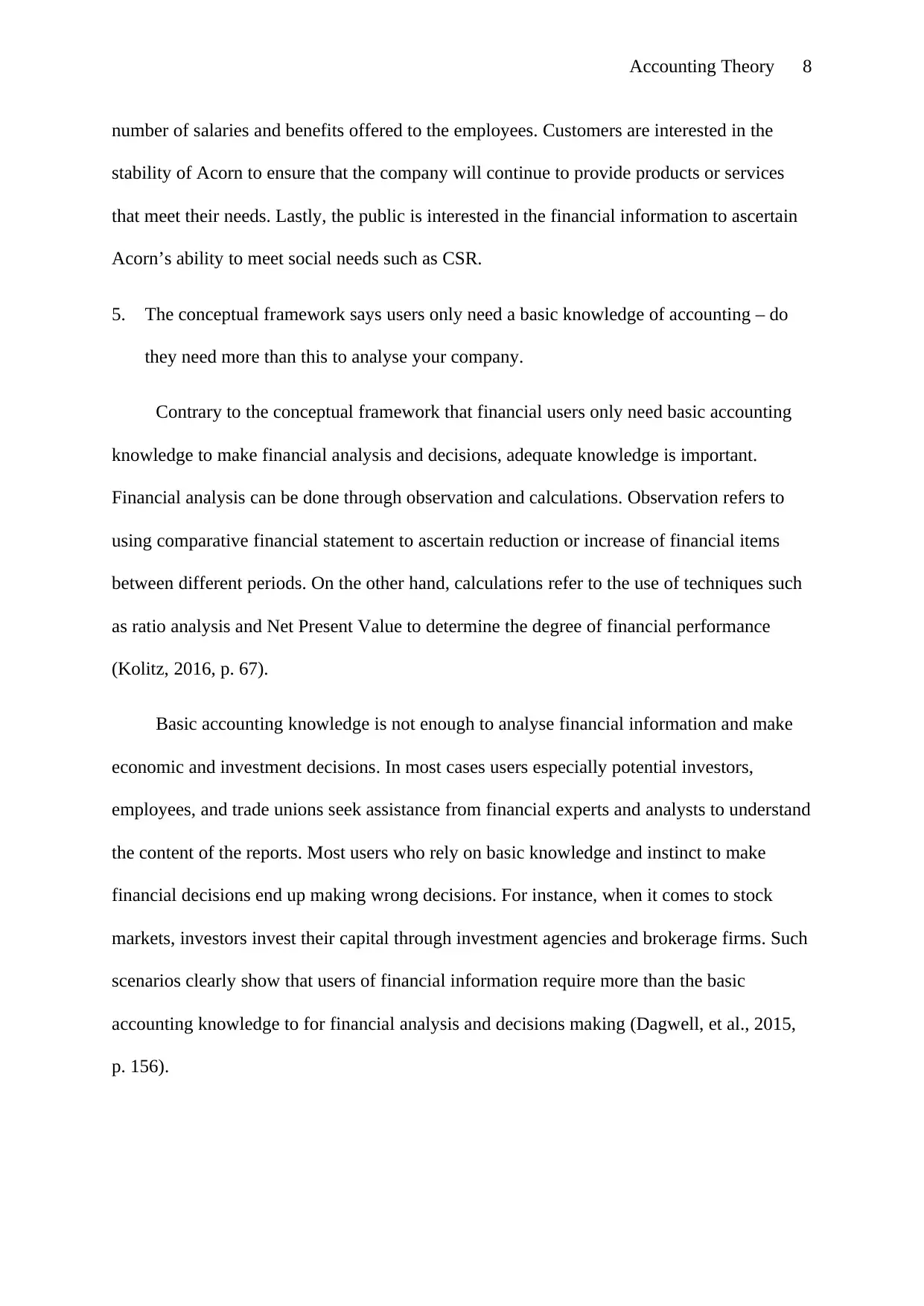
Accounting Theory 8
number of salaries and benefits offered to the employees. Customers are interested in the
stability of Acorn to ensure that the company will continue to provide products or services
that meet their needs. Lastly, the public is interested in the financial information to ascertain
Acorn’s ability to meet social needs such as CSR.
5. The conceptual framework says users only need a basic knowledge of accounting – do
they need more than this to analyse your company.
Contrary to the conceptual framework that financial users only need basic accounting
knowledge to make financial analysis and decisions, adequate knowledge is important.
Financial analysis can be done through observation and calculations. Observation refers to
using comparative financial statement to ascertain reduction or increase of financial items
between different periods. On the other hand, calculations refer to the use of techniques such
as ratio analysis and Net Present Value to determine the degree of financial performance
(Kolitz, 2016, p. 67).
Basic accounting knowledge is not enough to analyse financial information and make
economic and investment decisions. In most cases users especially potential investors,
employees, and trade unions seek assistance from financial experts and analysts to understand
the content of the reports. Most users who rely on basic knowledge and instinct to make
financial decisions end up making wrong decisions. For instance, when it comes to stock
markets, investors invest their capital through investment agencies and brokerage firms. Such
scenarios clearly show that users of financial information require more than the basic
accounting knowledge to for financial analysis and decisions making (Dagwell, et al., 2015,
p. 156).
number of salaries and benefits offered to the employees. Customers are interested in the
stability of Acorn to ensure that the company will continue to provide products or services
that meet their needs. Lastly, the public is interested in the financial information to ascertain
Acorn’s ability to meet social needs such as CSR.
5. The conceptual framework says users only need a basic knowledge of accounting – do
they need more than this to analyse your company.
Contrary to the conceptual framework that financial users only need basic accounting
knowledge to make financial analysis and decisions, adequate knowledge is important.
Financial analysis can be done through observation and calculations. Observation refers to
using comparative financial statement to ascertain reduction or increase of financial items
between different periods. On the other hand, calculations refer to the use of techniques such
as ratio analysis and Net Present Value to determine the degree of financial performance
(Kolitz, 2016, p. 67).
Basic accounting knowledge is not enough to analyse financial information and make
economic and investment decisions. In most cases users especially potential investors,
employees, and trade unions seek assistance from financial experts and analysts to understand
the content of the reports. Most users who rely on basic knowledge and instinct to make
financial decisions end up making wrong decisions. For instance, when it comes to stock
markets, investors invest their capital through investment agencies and brokerage firms. Such
scenarios clearly show that users of financial information require more than the basic
accounting knowledge to for financial analysis and decisions making (Dagwell, et al., 2015,
p. 156).
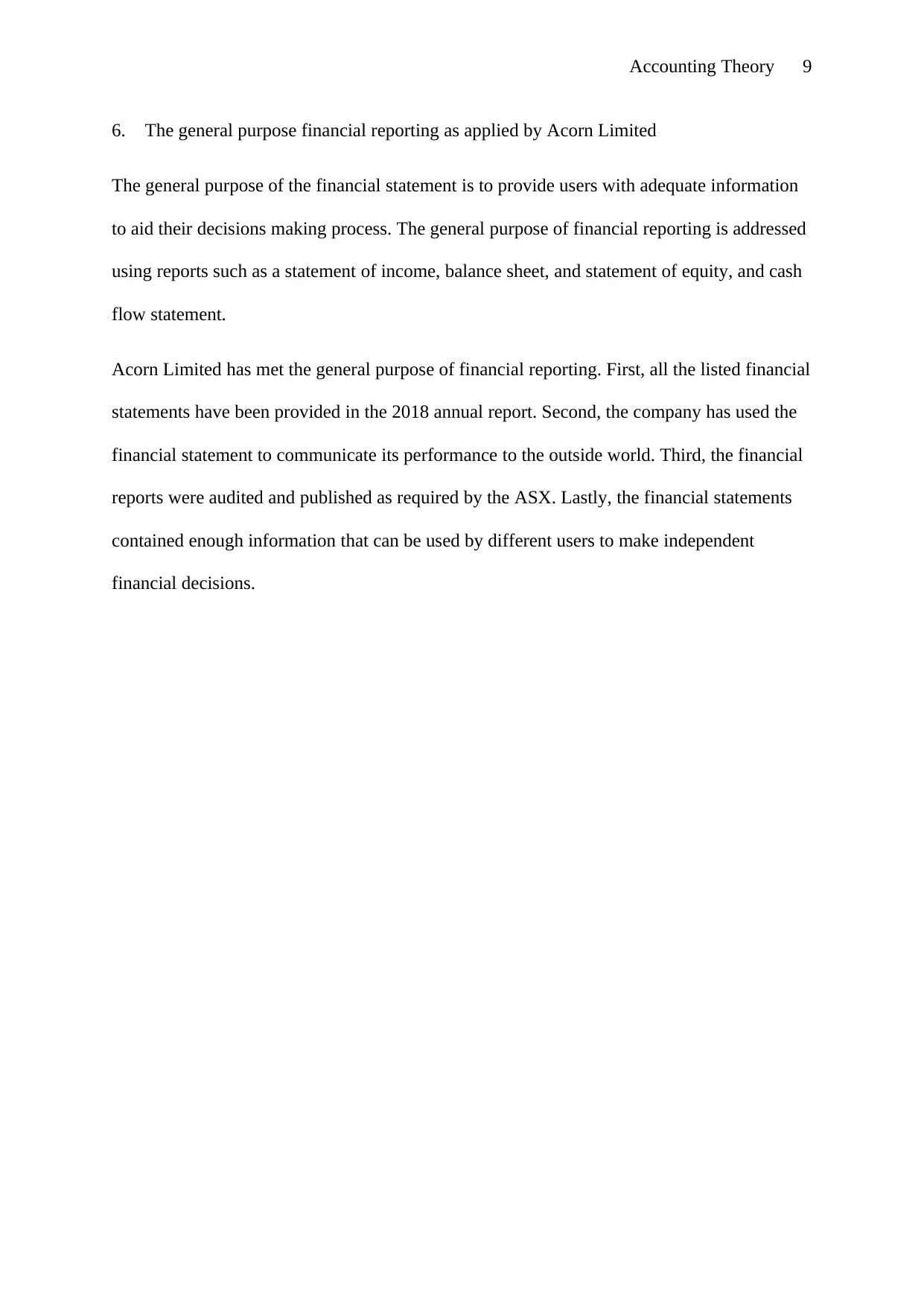
Accounting Theory 9
6. The general purpose financial reporting as applied by Acorn Limited
The general purpose of the financial statement is to provide users with adequate information
to aid their decisions making process. The general purpose of financial reporting is addressed
using reports such as a statement of income, balance sheet, and statement of equity, and cash
flow statement.
Acorn Limited has met the general purpose of financial reporting. First, all the listed financial
statements have been provided in the 2018 annual report. Second, the company has used the
financial statement to communicate its performance to the outside world. Third, the financial
reports were audited and published as required by the ASX. Lastly, the financial statements
contained enough information that can be used by different users to make independent
financial decisions.
6. The general purpose financial reporting as applied by Acorn Limited
The general purpose of the financial statement is to provide users with adequate information
to aid their decisions making process. The general purpose of financial reporting is addressed
using reports such as a statement of income, balance sheet, and statement of equity, and cash
flow statement.
Acorn Limited has met the general purpose of financial reporting. First, all the listed financial
statements have been provided in the 2018 annual report. Second, the company has used the
financial statement to communicate its performance to the outside world. Third, the financial
reports were audited and published as required by the ASX. Lastly, the financial statements
contained enough information that can be used by different users to make independent
financial decisions.
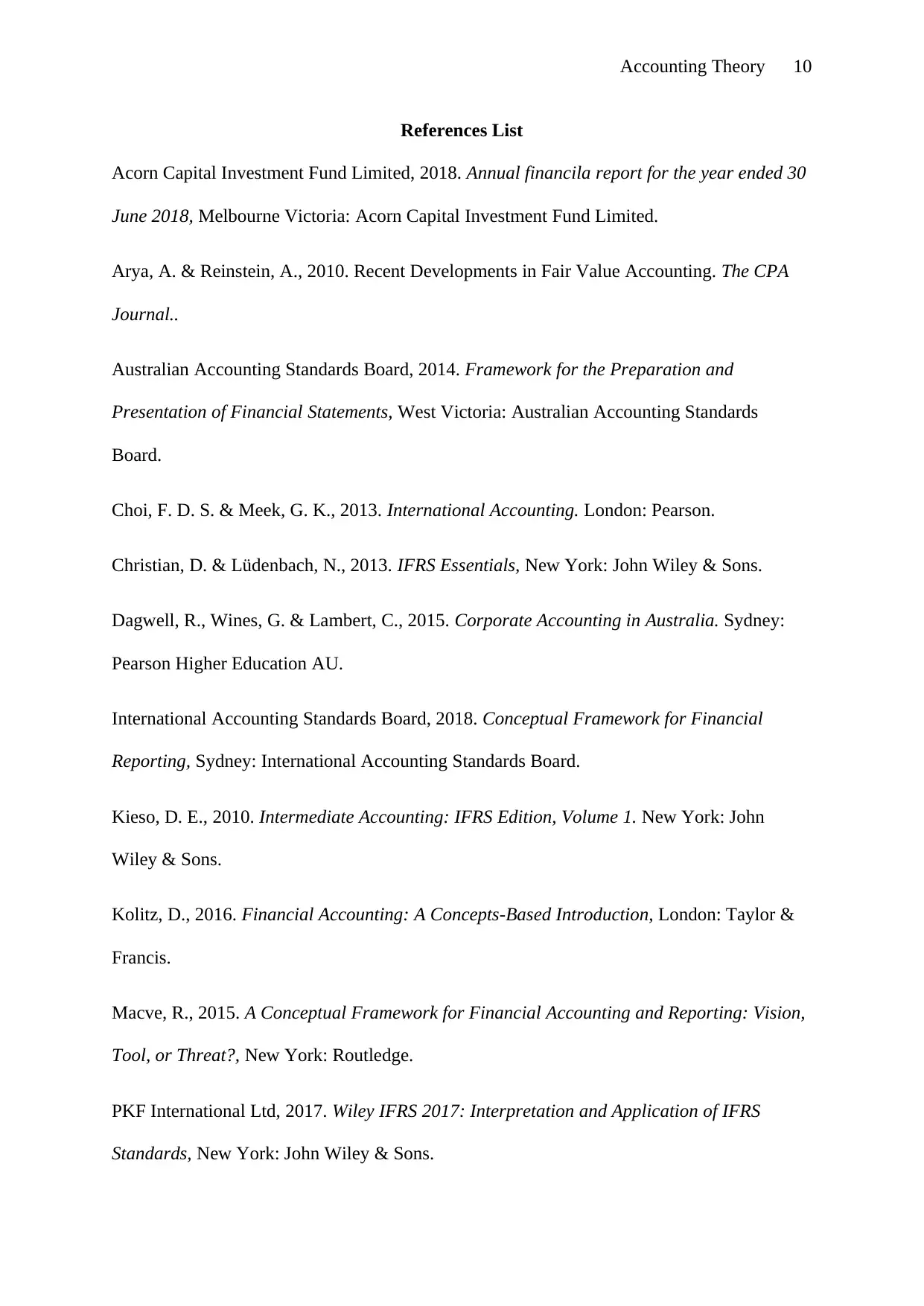
Accounting Theory 10
References List
Acorn Capital Investment Fund Limited, 2018. Annual financila report for the year ended 30
June 2018, Melbourne Victoria: Acorn Capital Investment Fund Limited.
Arya, A. & Reinstein, A., 2010. Recent Developments in Fair Value Accounting. The CPA
Journal..
Australian Accounting Standards Board, 2014. Framework for the Preparation and
Presentation of Financial Statements, West Victoria: Australian Accounting Standards
Board.
Choi, F. D. S. & Meek, G. K., 2013. International Accounting. London: Pearson.
Christian, D. & Lüdenbach, N., 2013. IFRS Essentials, New York: John Wiley & Sons.
Dagwell, R., Wines, G. & Lambert, C., 2015. Corporate Accounting in Australia. Sydney:
Pearson Higher Education AU.
International Accounting Standards Board, 2018. Conceptual Framework for Financial
Reporting, Sydney: International Accounting Standards Board.
Kieso, D. E., 2010. Intermediate Accounting: IFRS Edition, Volume 1. New York: John
Wiley & Sons.
Kolitz, D., 2016. Financial Accounting: A Concepts-Based Introduction, London: Taylor &
Francis.
Macve, R., 2015. A Conceptual Framework for Financial Accounting and Reporting: Vision,
Tool, or Threat?, New York: Routledge.
PKF International Ltd, 2017. Wiley IFRS 2017: Interpretation and Application of IFRS
Standards, New York: John Wiley & Sons.
References List
Acorn Capital Investment Fund Limited, 2018. Annual financila report for the year ended 30
June 2018, Melbourne Victoria: Acorn Capital Investment Fund Limited.
Arya, A. & Reinstein, A., 2010. Recent Developments in Fair Value Accounting. The CPA
Journal..
Australian Accounting Standards Board, 2014. Framework for the Preparation and
Presentation of Financial Statements, West Victoria: Australian Accounting Standards
Board.
Choi, F. D. S. & Meek, G. K., 2013. International Accounting. London: Pearson.
Christian, D. & Lüdenbach, N., 2013. IFRS Essentials, New York: John Wiley & Sons.
Dagwell, R., Wines, G. & Lambert, C., 2015. Corporate Accounting in Australia. Sydney:
Pearson Higher Education AU.
International Accounting Standards Board, 2018. Conceptual Framework for Financial
Reporting, Sydney: International Accounting Standards Board.
Kieso, D. E., 2010. Intermediate Accounting: IFRS Edition, Volume 1. New York: John
Wiley & Sons.
Kolitz, D., 2016. Financial Accounting: A Concepts-Based Introduction, London: Taylor &
Francis.
Macve, R., 2015. A Conceptual Framework for Financial Accounting and Reporting: Vision,
Tool, or Threat?, New York: Routledge.
PKF International Ltd, 2017. Wiley IFRS 2017: Interpretation and Application of IFRS
Standards, New York: John Wiley & Sons.
Secure Best Marks with AI Grader
Need help grading? Try our AI Grader for instant feedback on your assignments.
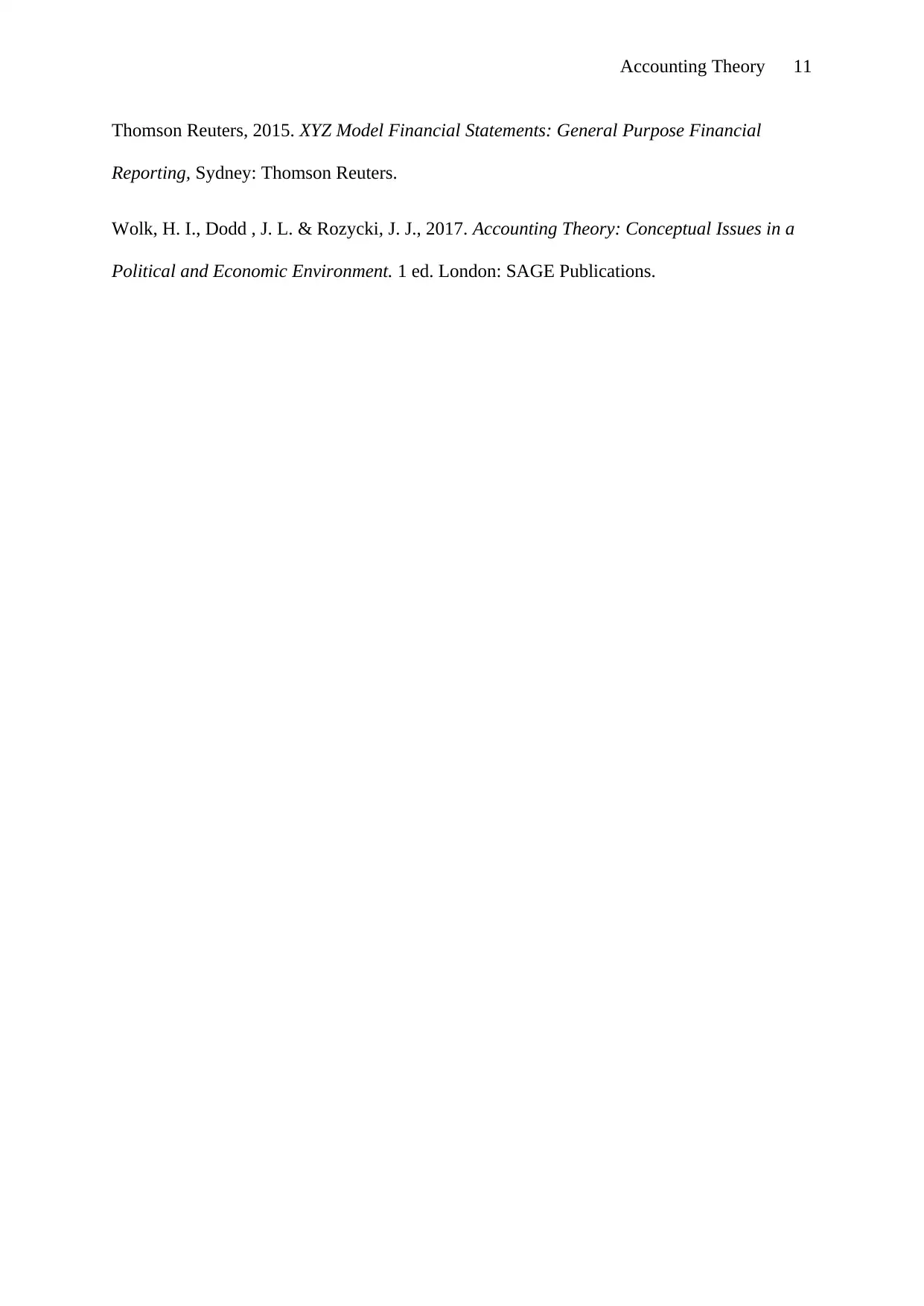
Accounting Theory 11
Thomson Reuters, 2015. XYZ Model Financial Statements: General Purpose Financial
Reporting, Sydney: Thomson Reuters.
Wolk, H. I., Dodd , J. L. & Rozycki, J. J., 2017. Accounting Theory: Conceptual Issues in a
Political and Economic Environment. 1 ed. London: SAGE Publications.
Thomson Reuters, 2015. XYZ Model Financial Statements: General Purpose Financial
Reporting, Sydney: Thomson Reuters.
Wolk, H. I., Dodd , J. L. & Rozycki, J. J., 2017. Accounting Theory: Conceptual Issues in a
Political and Economic Environment. 1 ed. London: SAGE Publications.
1 out of 11
Related Documents
Your All-in-One AI-Powered Toolkit for Academic Success.
+13062052269
info@desklib.com
Available 24*7 on WhatsApp / Email
![[object Object]](/_next/static/media/star-bottom.7253800d.svg)
Unlock your academic potential
© 2024 | Zucol Services PVT LTD | All rights reserved.





